Omar Hashash
Large-Scale AI in Telecom: Charting the Roadmap for Innovation, Scalability, and Enhanced Digital Experiences
Mar 06, 2025Abstract:This white paper discusses the role of large-scale AI in the telecommunications industry, with a specific focus on the potential of generative AI to revolutionize network functions and user experiences, especially in the context of 6G systems. It highlights the development and deployment of Large Telecom Models (LTMs), which are tailored AI models designed to address the complex challenges faced by modern telecom networks. The paper covers a wide range of topics, from the architecture and deployment strategies of LTMs to their applications in network management, resource allocation, and optimization. It also explores the regulatory, ethical, and standardization considerations for LTMs, offering insights into their future integration into telecom infrastructure. The goal is to provide a comprehensive roadmap for the adoption of LTMs to enhance scalability, performance, and user-centric innovation in telecom networks.
Artificial General Intelligence (AGI)-Native Wireless Systems: A Journey Beyond 6G
Apr 29, 2024



Abstract:Building future wireless systems that support services like digital twins (DTs) is challenging to achieve through advances to conventional technologies like meta-surfaces. While artificial intelligence (AI)-native networks promise to overcome some limitations of wireless technologies, developments still rely on AI tools like neural networks. Such tools struggle to cope with the non-trivial challenges of the network environment and the growing demands of emerging use cases. In this paper, we revisit the concept of AI-native wireless systems, equipping them with the common sense necessary to transform them into artificial general intelligence (AGI)-native systems. These systems acquire common sense by exploiting different cognitive abilities such as perception, analogy, and reasoning, that enable them to generalize and deal with unforeseen scenarios. Towards developing the components of such a system, we start by showing how the perception module can be built through abstracting real-world elements into generalizable representations. These representations are then used to create a world model, founded on principles of causality and hyper-dimensional (HD) computing, that aligns with intuitive physics and enables analogical reasoning, that define common sense. Then, we explain how methods such as integrated information theory play a role in the proposed intent-driven and objective-driven planning methods that maneuver the AGI-native network to take actions. Next, we discuss how an AGI-native network can enable use cases related to human and autonomous agents: a) analogical reasoning for next-generation DTs, b) synchronized and resilient experiences for cognitive avatars, and c) brain-level metaverse experiences like holographic teleportation. Finally, we conclude with a set of recommendations to build AGI-native systems. Ultimately, we envision this paper as a roadmap for the beyond 6G era.
Large Multi-Modal Models (LMMs) as Universal Foundation Models for AI-Native Wireless Systems
Feb 07, 2024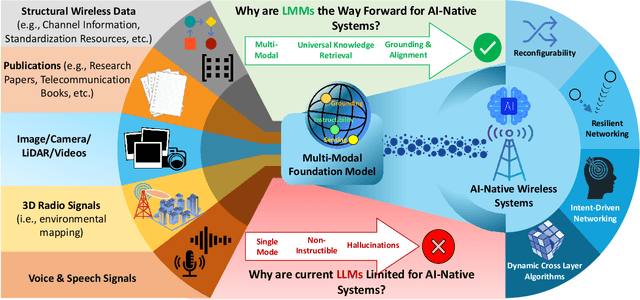
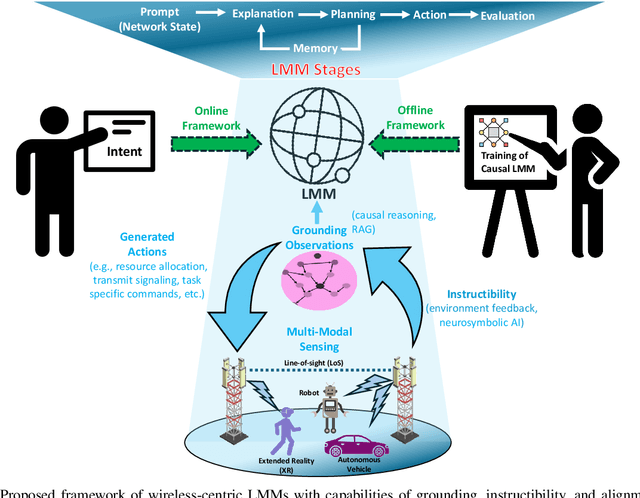
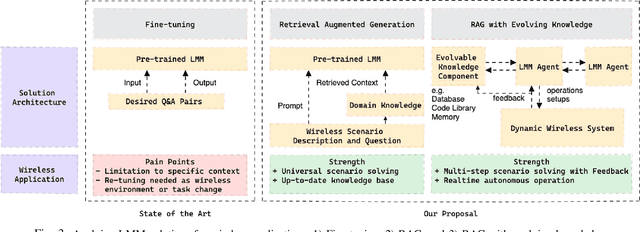
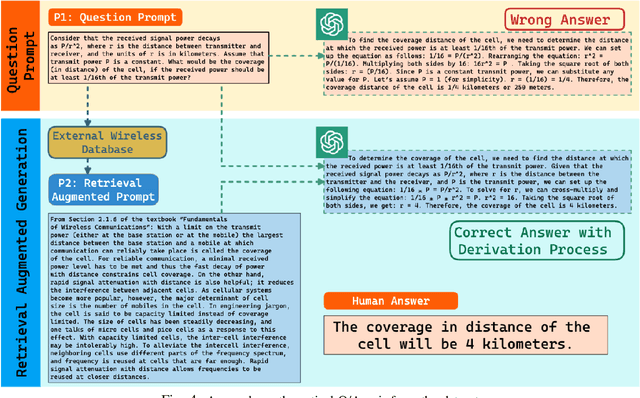
Abstract:Large language models (LLMs) and foundation models have been recently touted as a game-changer for 6G systems. However, recent efforts on LLMs for wireless networks are limited to a direct application of existing language models that were designed for natural language processing (NLP) applications. To address this challenge and create wireless-centric foundation models, this paper presents a comprehensive vision on how to design universal foundation models that are tailored towards the deployment of artificial intelligence (AI)-native networks. Diverging from NLP-based foundation models, the proposed framework promotes the design of large multi-modal models (LMMs) fostered by three key capabilities: 1) processing of multi-modal sensing data, 2) grounding of physical symbol representations in real-world wireless systems using causal reasoning and retrieval-augmented generation (RAG), and 3) enabling instructibility from the wireless environment feedback to facilitate dynamic network adaptation thanks to logical and mathematical reasoning facilitated by neuro-symbolic AI. In essence, these properties enable the proposed LMM framework to build universal capabilities that cater to various cross-layer networking tasks and alignment of intents across different domains. Preliminary results from experimental evaluation demonstrate the efficacy of grounding using RAG in LMMs, and showcase the alignment of LMMs with wireless system designs. Furthermore, the enhanced rationale exhibited in the responses to mathematical questions by LMMs, compared to vanilla LLMs, demonstrates the logical and mathematical reasoning capabilities inherent in LMMs. Building on those results, we present a sequel of open questions and challenges for LMMs. We then conclude with a set of recommendations that ignite the path towards LMM-empowered AI-native systems.
Internet of Federated Digital Twins (IoFDT): Connecting Twins Beyond Borders for Society 5.0
Dec 11, 2023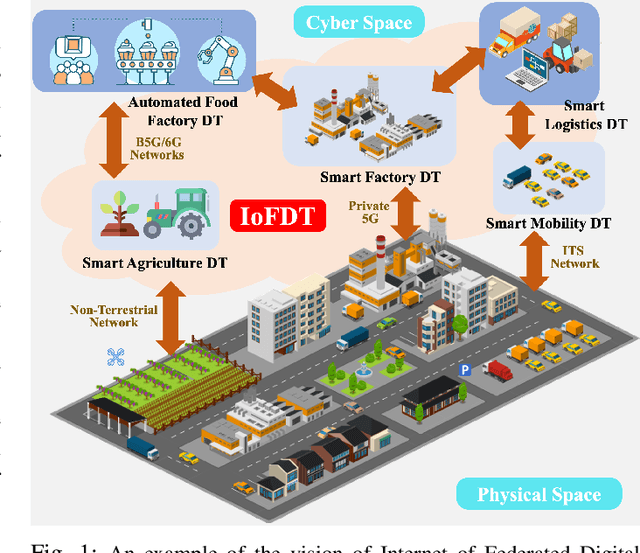
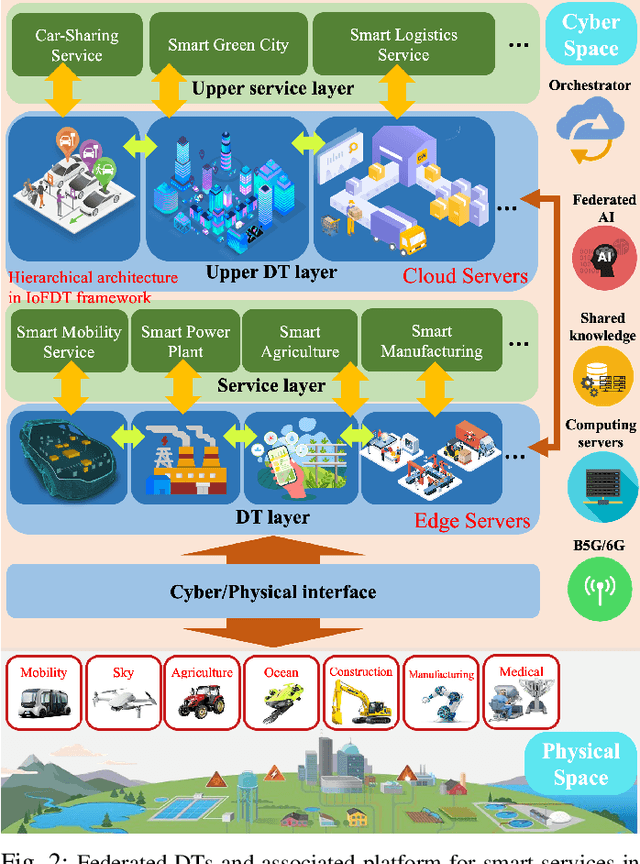
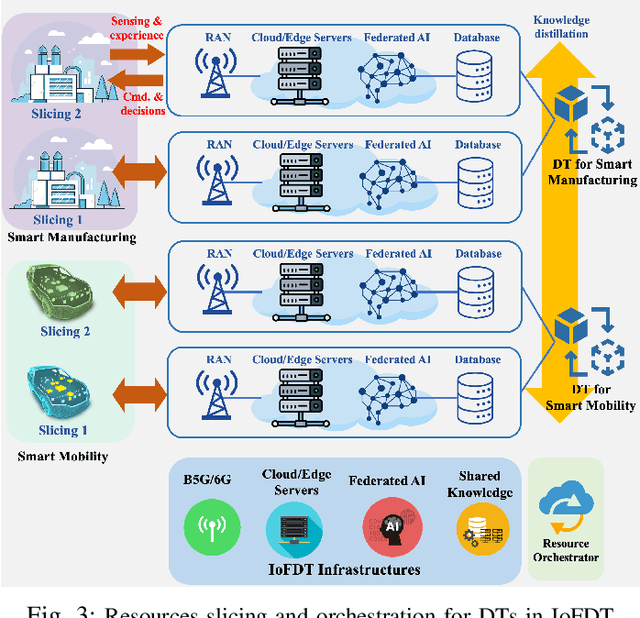
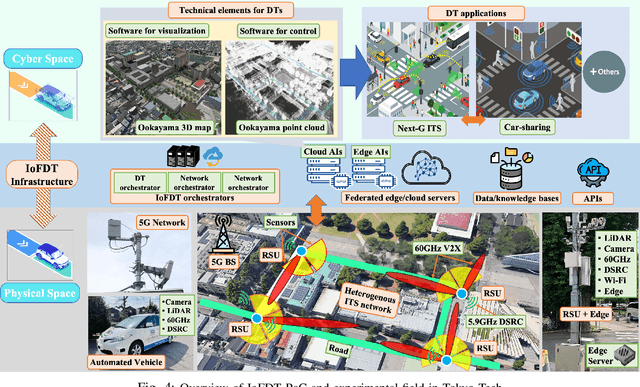
Abstract:The concept of digital twin (DT), which enables the creation of a programmable, digital representation of physical systems, is expected to revolutionize future industries and will lie at the heart of the vision of a future smart society, namely, Society 5.0, in which high integration between cyber (digital) and physical spaces is exploited to bring economic and societal advancements. However, the success of such a DT-driven Society 5.0 requires a synergistic convergence of artificial intelligence and networking technologies into an integrated, programmable system that can coordinate networks of DTs to effectively deliver diverse Society 5.0 services. Prior works remain restricted to either qualitative study, simple analysis or software implementations of a single DT, and thus, they cannot provide the highly synergistic integration of digital and physical spaces as required by Society 5.0. In contrast, this paper envisions a novel concept of an Internet of Federated Digital Twins (IoFDT) that holistically integrates heterogeneous and physically separated DTs representing different Society 5.0 services within a single framework and system. For this concept of IoFDT, we first introduce a hierarchical architecture that integrates federated DTs through horizontal and vertical interactions, bridging the cyber and physical spaces to unlock new possibilities. Then, we discuss the challenges of realizing IoFDT, highlighting the intricacies across communication, computing, and AI-native networks while also underscoring potential innovative solutions. Subsequently, we elaborate on the importance of the implementation of a unified IoFDT platform that integrates all technical components and orchestrates their interactions, emphasizing the necessity of practical experimental platforms with a focus on real-world applications in areas like smart mobility.
UAV-Aided Lifelong Learning for AoI and Energy Optimization in Non-Stationary IoT Networks
Dec 01, 2023



Abstract:In this paper, a novel joint energy and age of information (AoI) optimization framework for IoT devices in a non-stationary environment is presented. In particular, IoT devices that are distributed in the real-world are required to efficiently utilize their computing resources so as to balance the freshness of their data and their energy consumption. To optimize the performance of IoT devices in such a dynamic setting, a novel lifelong reinforcement learning (RL) solution that enables IoT devices to continuously adapt their policies to each newly encountered environment is proposed. Given that IoT devices have limited energy and computing resources, an unmanned aerial vehicle (UAV) is leveraged to visit the IoT devices and update the policy of each device sequentially. As such, the UAV is exploited as a mobile learning agent that can learn a shared knowledge base with a feature base in its training phase, and feature sets of a zero-shot learning method in its testing phase, to generalize between the environments. To optimize the trajectory and flying velocity of the UAV, an actor-critic network is leveraged so as to minimize the UAV energy consumption. Simulation results show that the proposed lifelong RL solution can outperform the state-of-art benchmarks by enhancing the balanced cost of IoT devices by $8.3\%$ when incorporating warm-start policies for unseen environments. In addition, our solution achieves up to $49.38\%$ reduction in terms of energy consumption by the UAV in comparison to the random flying strategy.
The Seven Worlds and Experiences of the Wireless Metaverse: Challenges and Opportunities
Apr 20, 2023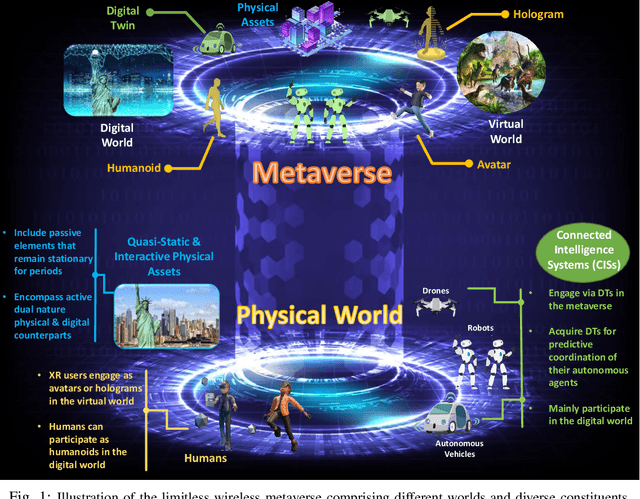
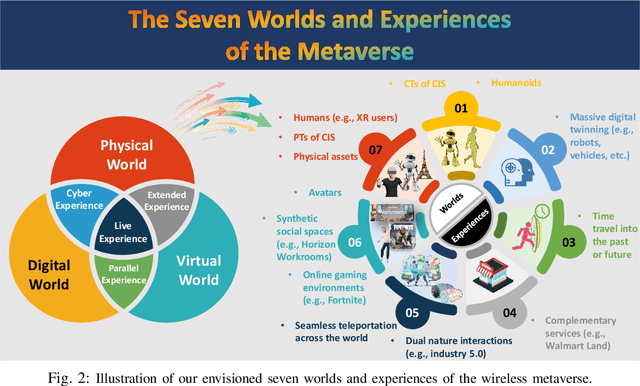
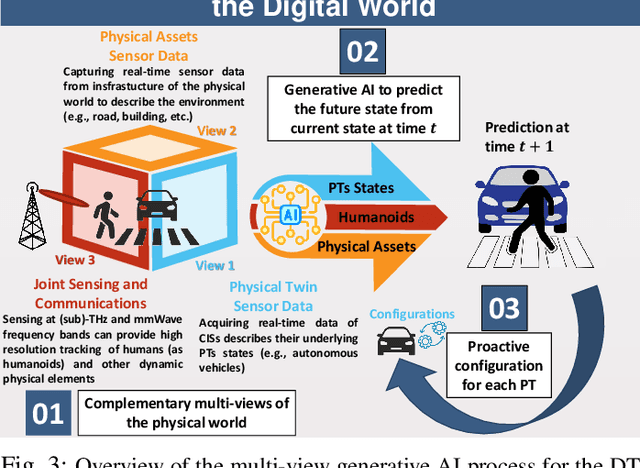
Abstract:The wireless metaverse will create diverse user experiences at the intersection of the physical, digital, and virtual worlds. These experiences will enable novel interactions between the constituents (e.g., extended reality (XR) users and avatars) of the three worlds. However, remarkably, to date, there is no holistic vision that identifies the full set of metaverse worlds, constituents, and experiences, and the implications of their associated interactions on next-generation communication and computing systems. In this paper, we present a holistic vision of a limitless, wireless metaverse that distills the metaverse into an intersection of seven worlds and experiences that include the: i) physical, digital, and virtual worlds, along with the ii) cyber, extended, live, and parallel experiences. We then articulate how these experiences bring forth interactions between diverse metaverse constituents, namely, a) humans and avatars and b) connected intelligence systems and their digital twins (DTs). Then, we explore the wireless, computing, and artificial intelligence (AI) challenges that must be addressed to establish metaverse-ready networks that support these experiences and interactions. We particularly highlight the need for end-to-end synchronization of DTs, and the role of human-level AI and reasoning abilities for cognitive avatars. Moreover, we articulate a sequel of open questions that should ignite the quest for the future metaverse. We conclude with a set of recommendations to deploy the limitless metaverse over future wireless systems.
Simultaneous Transmitting and Reflecting (STAR)-RIS for Harmonious Millimeter Wave Spectrum Sharing
Jan 25, 2023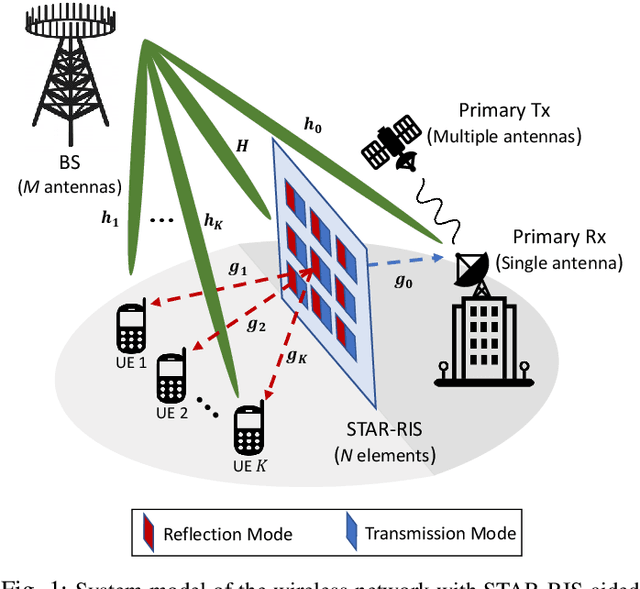
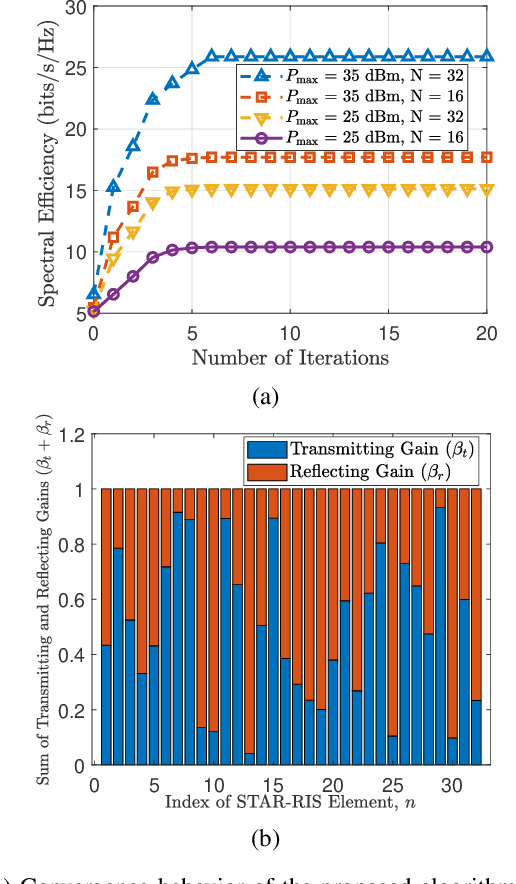
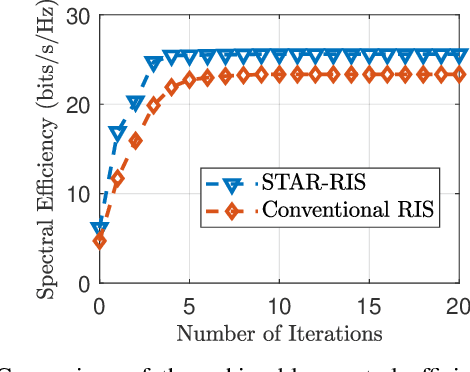
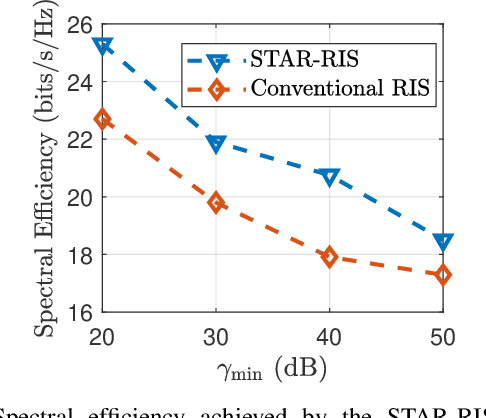
Abstract:The opening of the millimeter wave (mmWave) spectrum bands for 5G communications has motivated the need for novel spectrum sharing solutions at these high frequencies. In fact, reconfigurable intelligent surfaces (RISs) have recently emerged to enable spectrum sharing while enhancing the incumbents' quality-of-service (QoS). Nonetheless, co-existence over mmWave bands remains persistently challenging due to their unfavorable propagation characteristics. Hence, initiating mmWave spectrum sharing requires the RIS to further assist in improving the QoS over mmWave bands without jeopardizing spectrum sharing demands. In this paper, a novel simultaneous transmitting and reflecting RIS (STAR-RIS)-aided solution to enable mmWave spectrum sharing is proposed. In particular, the transmitting and reflecting abilities of the STAR-RIS are leveraged to tackle the mmWave spectrum sharing and QoS requirements separately. The STAR-RIS-enabled spectrum sharing problem between a primary network (e.g. a radar transmit-receive pair) and a secondary network is formulated as an optimization problem whose goal is to maximize the downlink sum-rate over a secondary multiple-input-single-output (MISO) network, while limiting interference over a primary network. Moreover, the STAR-RIS response coefficients and beamforming matrix in the secondary network are jointly optimized. To solve this non-convex problem, an alternating iterative algorithm is employed, where the STAR-RIS response coefficients and beamforming matrix are obtained using the successive convex approximation method. Simulation results show that the proposed solution outperforms conventional RIS schemes for mmWave spectrum sharing by achieving a 14.57% spectral efficiency gain.
Edge Continual Learning for Dynamic Digital Twins over Wireless Networks
Apr 10, 2022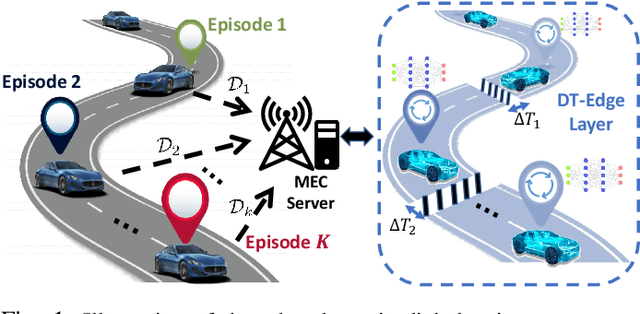
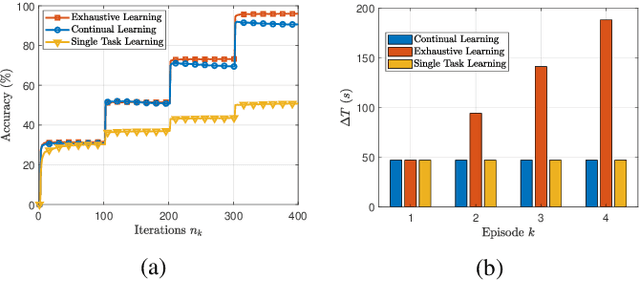
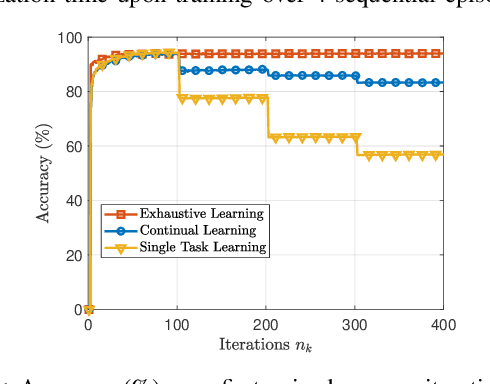
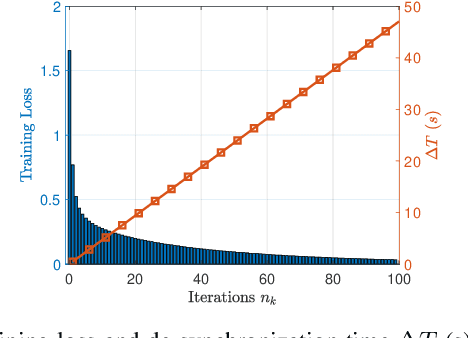
Abstract:Digital twins (DTs) constitute a critical link between the real-world and the metaverse. To guarantee a robust connection between these two worlds, DTs should maintain accurate representations of the physical applications, while preserving synchronization between real and digital entities. In this paper, a novel edge continual learning framework is proposed to accurately model the evolving affinity between a physical twin (PT) and its corresponding cyber twin (CT) while maintaining their utmost synchronization. In particular, a CT is simulated as a deep neural network (DNN) at the wireless network edge to model an autonomous vehicle traversing an episodically dynamic environment. As the vehicular PT updates its driving policy in each episode, the CT is required to concurrently adapt its DNN model to the PT, which gives rise to a de-synchronization gap. Considering the history-aware nature of DTs, the model update process is posed a dual objective optimization problem whose goal is to jointly minimize the loss function over all encountered episodes and the corresponding de-synchronization time. As the de-synchronization time continues to increase over sequential episodes, an elastic weight consolidation (EWC) technique that regularizes the DT history is proposed to limit de-synchronization time. Furthermore, to address the plasticity-stability tradeoff accompanying the progressive growth of the EWC regularization terms, a modified EWC method that considers fair execution between the historical episodes of the DTs is adopted. Ultimately, the proposed framework achieves a simultaneously accurate and synchronous CT model that is robust to catastrophic forgetting. Simulation results show that the proposed solution can achieve an accuracy of 90 % while guaranteeing a minimal desynchronization time.
 Add to Chrome
Add to Chrome Add to Firefox
Add to Firefox Add to Edge
Add to Edge